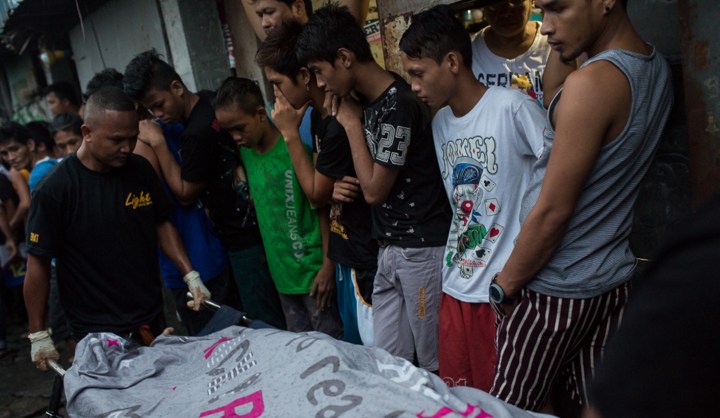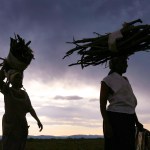World
Reporter’s Notebook: A year into Duterte’s bloody war on drugs, little has changed

The Philippines – where murder is normalised, genocide is considered unremarkable and carnage is, somehow, acceptable. Story and Photos by Shaun Swingler for CHRONICLE.
We’re sitting in a cramped and claustrophobic house in the middle of a rabbit warren of small alleyways in the fishing town of Navotas, Metro Manila. It’s 40 degrees outside.
The tiny room where we sit is seething with something that feels like panic, or shock. Or grief that is waiting for its chance to be felt.
I am trying to find the words to ask the mother of two dead sons how she chose which of them to bury.

Photo: Maria Misa De Pirini in her home in Navotas on 12 September
Maria Misa De Pirini’s sons Danilo and Aljon were both casualties in the Philippines President Rodrigo Duterte’s deadly war on drugs. At the time of their killings, Duterte had been in office for three months and his drug war had already led to the deaths of an estimated 4,000 drug users by police and vigilante killers. Today, a year after the president’s inauguration, that figure is now over 9,000.
Maria was one of many working-class people who voted for Duterte, believing his promises to end both corruption and the scourge of drug abuse. A perceived representative of the working class, he won in a landslide victory. But his promises led to unfettered, state sanctioned killing of many of the Philippines’ most vulnerable people: the poor, who often use drugs to escape their everyday realities.

Photo: Quezon City Jail was built to house 400 inmates but, as of September 11 2016, currently houses 3669 inmates. The prison has seen a drastic increase in intake since the war on drugs was announced, with 62% of inmates incarcerated for drug cases. The jail has a planned ‘decongestion’ strategy, but prison officials admit progress is slow. 16 September.
On the first day of Duterte’s term in office, his “war on drugs” claimed four lives, on the second, 14 and on the ninth, 30. That number soon rose. Often the victims’ heads would be wrapped in packing tape, with crude messages scrawled on cardboard next to the bodies, labelling them drug pushers or users. Bodies piled up.
The day after Aljon was murdered, I joined a group of local journalists covering “the Night Beat” – essentially the reporting of the latest “drug war” killings and their aftermath. That night, we got a call saying there had been a drug-related killing in a nearby city in Metro Manila called Caloocan. We drove to the scene in convoy.

Photo: Police officers conduct Oplan Tokhang, “Knock and Plead” operations, in Payatas, Quezon City, on 16 September.
Guided by the blue and red lights of the police and SOCO vans, journalists readied their gear, switched on LED lights, and moved quickly down the dark, tungsten-lit alleyways towards the scene. The body of a man, lying face down, confronted us as we arrived. He was shirtless, wearing dark blue shorts and sandals. His torso was covered in blood that body collectors tried to wipe off before they loaded him on to the stretcher to carry him away.
From what we could gather, the man was shot and killed by police during what’s known as a buy-bust operation – an undercover sting operation where a police officer impersonates a drug dealer. When the would-be drug buyers attempt to “resist arrest”, they are shot and killed by the undercover officer on site.

Photo: The wife of an unidentified man killed by police sweeps away his blood after his body is removed from the scene on 22 September.
For a moment there was a stillness to the scene. Camera shutters clicked, SOCO outlined the positions of bullet cartridges on the ground in chalk, their torches occasionally illuminating the dead man’s face. Jarringly, a rooster crowed. Two women sat metres away and cried. We later found out that one of them was the deceased man’s wife. She threw buckets of water on the concrete outside her home to wash away the blood; crimson rivulets streamed down the alleyway. No witness statements were taken, and all of us knew that no one would be held to account for this man’s murder.
We didn’t stay for long – a colleague got a call saying there had been another drug killing 10 minutes away.
Instead of resolution, or some promise of justice, the media covering this drug war can only capture thousands of different portraits of grief.
The woman who cries while she washes her husband’s blood away.
The mother who must chose which of her sons to bury.

Photo: Relatives gather before Adonis Dela Rosa’s entombment.
When I first spoke to Maria Misa De Pirini after the murders of both of her sons, she appeared visibly shocked that they had become fatalities in a drug war that she had initially supported. She spoke in monotone, so disbelieving in her grief that her own tears seemed to surprise her. Like they belonged to someone else.
Aljon had been the first to die.
He had told his mother he used drugs to make his body stronger for work at the fish factory where he and his brother found employment. It’s more likely that being high made his job bearable.
On 21 September 2016, masked men came to Maria’s house demanding to take Aljon and his friend, a known drug pusher, away. Maria pleaded with them, asking for mercy. She knew that if they took him, she night never see him again. Her pleas fell on deaf ears.

Photo: An unidentified man is killed in a suspected ‘buy-bust’ operation in Caloocan. 22 September.
Police later told Maria that two bodies had been found under a bridge close to her home. When she arrived she saw one of them was Aljon. His body was beaten, with two gunshot wounds to the chest, one to the head.
After Aljon died, Maria feared that Danilo might be next. She told him to keep a low profile in the area. Those warnings were in vain. A week later, masked men – suspected to be police – apprehended him and the men he was seeking refuge with. He was severely beaten, shot and dumped under the same bridge where Aljon’s body was found.
No one was arrested for either murder, and any hope of justice for her sons was a luxury that Maria simply could not afford. Maria’s poverty had also forced her into making a terrible choice, heartbreaking in its banality. Which son’s body to bury, and which to leave unclaimed?
When I tried to ask Maria how she had made that choice, my fixer and I were sitting on the floor of her two-square-metre living room-cum-kitchen. The floor above us had been used as a space to sleep for Maria, her daughter, and – until very recently – Danilo and Aljon.
Danilo’s name tag for the recycling depot he sometimes worked at still hung up on the wall of her living room, next to a teddy bear and a Catholic statue.
My question got lost in translation, misinterpreted as me asking Maria which of her sons she loved the most. Her response was confused, and I couldn’t understand it.

Photo: Cemetery workers hoist Dela Rosa’s coffin into his tomb.
Days later, I went with Maria to the Navotas funeral parlour where Danilo’s body was being kept. The parlour’s director, Orly Fernandez, admitted that they had run out of space to store the bodies that had flooded in as the “war on drugs” intensified. He showed me how bodies were piled on top of each other, sometimes three deep, on the floor.
He then pointed to Danilo’s body, lying on the floor wrapped in a blue and yellow Hello Kitty blanket.
Maria had asked Fernandez for a discount on Danilo’s burial, and he agreed, but it was still too expensive for her to afford. She was forced to accept that the only way to bury her son was to leave his body unclaimed, and hope that would get included in the next mass burial of unclaimed bodies the funeral parlour conducted. Four months later, in January 2017, Danilo’s body was buried in the grave of a woman also killed in a police drug operation. The grave bears only the woman’s name, as Maria couldn’t afford a tombstone for Danilo.
Her choice, I now know, was driven by the fact that Aljon’s funeral parlour did not offer the option of a pauper’s burial. It wasn’t an epic dilemma driven by love or connection, but a painfully simple choice, driven by Maria’s economic reality.
If I am honest, I wanted there to be a powerful emotional force behind Maria’s choice. One that would subsume her sons’ battered bodies, the bullet holes to their heads. The Hello Kitty blanket wrapped around Danilo’s broken bones. The unmarked grave he shares with another dead drug user.
Without that choice being something beyond these simple horrors, this story effectively just captures murder that is normalised, genocide that is considered unremarkable and carnage that is, somehow, acceptable.
We sweep the blood away and move on. Like there is no heartbreak here. DM
Fixing and additional reporting by Guill Ramos
Shaun Swingler spent a month in the Philippines reporting on the drug war for various news outlets. In collaboration with Chronicle, he produced a short documentary film on the drug war which premiered at Encounters Documentary Film Festival where it won the EYE Youth Jury Award. A trailer for the film can be viewed here: https://www.youtube.com/watch?v=GPjRVknCW_Y
Photo: Undertakers transport the body of an alleged drug suspect who was killed by police in Sitio San Roque, Quezon City, on 14 September.



















 Become an Insider
Become an Insider